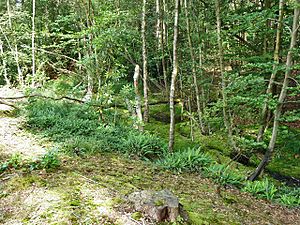St Leonard's Forest SSSI facts for kids
| Site of Special Scientific Interest | |
 |
|
| Area of Search | West Sussex |
|---|---|
| Interest | Biological |
| Area | 85.4 hectares (211 acres) |
| Notification | 1987 |
| Location map | Magic Map |
St Leonard's Forest SSSI is a very special natural area located east of Horsham in West Sussex, England. It's known as a Site of Special Scientific Interest (SSSI) because it holds important plants, animals, or unique geological features. This particular SSSI is important for its amazing wildlife and plants. It covers about 85.4 hectares, which is roughly the size of 211 football fields.
This SSSI is actually made up of two separate parts. The western part is inside the larger St Leonard's Forest, which is managed by the Forestry Commission. This bigger forest covers about 289 hectares.
Contents
What is a Site of Special Scientific Interest?
A Site of Special Scientific Interest, or SSSI, is a protected area in the United Kingdom. These places are chosen because they have some of the best examples of Britain's natural heritage. This could be rare wildlife, special plants, or important geological features like rocks and landforms.
Being an SSSI helps protect these areas. It means that any changes or developments in the area need special permission. This helps make sure that the important natural features are kept safe for the future.
Why is St Leonard's Forest SSSI Special?
St Leonard's Forest SSSI is special because of its rich variety of plants and animals. It's a great example of a healthy woodland ecosystem. The forest has been around for a very long time, which makes it even more valuable for nature.
Forest Life and Habitats
Most of St Leonard's Forest is a type of woodland called deciduous woodland. This means the trees lose their leaves in autumn and grow new ones in spring. It's a beautiful sight, especially when the leaves change color!
Trees of the Forest
The main trees you'll find here are the pedunculate oak, silver birch, and beech. There's also another type of birch called common birch (Betula pubescens). These trees create a dense canopy, which is like a roof of leaves, providing shade and shelter for many creatures.
Unique Microclimate and Ancient Plants
One part of the SSSI has a narrow valley with a very special environment. It has a humid microclimate, meaning it's always a bit damp and moist. This dampness is perfect for certain plants that love humidity.
Thanks to this special climate, some very old mosses and liverworts have survived here. These tiny plants are like living history books. Their presence suggests that this part of the forest has been continuously covered by woodland for an incredible 5,000 years! That's a very long time for a forest to stay untouched.
Amazing Butterflies
The forest is also home to some beautiful insects, including butterflies. One very special butterfly found here is the purple emperor. This butterfly is quite rare and known for its stunning, iridescent purple wings (on the males). Finding them in St Leonard's Forest shows how healthy and diverse the environment is.
Visiting St Leonard's Forest
If you're interested in exploring this natural wonder, you're in luck! There is public access to the western part of the St Leonard's Forest SSSI. This means you can visit and enjoy the beauty of the woodland, observe the trees, and perhaps even spot some of its unique wildlife. It's a great place for a walk and to connect with nature.

